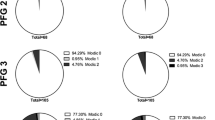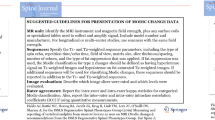Abstract
Purpose
The aims of the study were to introduce a classification scheme for endplate lesions based on T2-weighted magnetic resonance imaging and to detect possible associations between endplate lesions and other variables such as age, sex, disc degeneration and Modic changes in a large population.
Methods
MRI images of 996 low back pain patients were collected. All intervertebral spaces were classified as “normal”, “wavy/irregular”, “notched”, “Schmorl’s node” and “fracture”. The associations between endplate lesions and age, sex, disc degeneration and Modic changes were determined in the considered population.
Results
The most common endplate lesions were “notched” and “Schmorl’s nodes”. The prevalence was higher among the male subjects. In most patients (62.8%), no endplate lesions were detected, with a significant difference between male (57.5%) and female subjects (67.9%) (p < 0.001). Lesions were found to be associated with intervertebral disc degeneration (relative risk 2.49) and signal alterations (relative risk 3.08). Fleiss kappas of 0.73 and 0.89 were, respectively, assessed for the inter- and intra-observer reliabilities of the new classification system.
Conclusions
Endplate lesions were detected, classified with a novel scheme and analysed in a large population of patients suffering from low back pain based on MRI images. The reliability of the novel classification system was demonstrated.
Graphical abstract
These slides can be retrieved under Electronic Supplementary Material.




Similar content being viewed by others
References
Schmorl G (1927) Über die an den Wirbelbandscheiben vorkommenden Ausdehnungs- und Zerreissungsvorgänge und die dadurch an ihnen und der Wirbelspongiosa hervorgerufenen Veränderungen. Verhandlungen Dtsch Ges Für Pathol 22:250–262
Schmorl G, Junghanns H (1971) The human spine in health and disease. Grune and Stratton, New York
Putschar W (1927) Zur Kenntnis der Knorpelinseln in den Wirbelkörpern. Beitr Path Anat 79:150
Perey O (1957) Fracture of the vertebral end-plate in the lumbar spine: an experimental biomechanical investigation. Acta Orthop Scand 28(sup25):1–101
Kyere KA, Than KD, Wang AC, Rahman SU, Valdivia-Valdivia JM, La Marca F, Park P (2012) Schmorl’s nodes. Eur Spine J 21(11):2115–2121
Coventry MB, Ghormley RK, Kernohan JW (1945) The intervertebral disc: its microscopic anatomy and pathology: part III. Pathological changes in the intervertebral disc. J Bone Joint Surg 27(3):460–474
Hilton RC, Ball J, Benn RT (1976) Vertebral end-plate lesions (Schmorl’s nodes) in the dorsolumbar spine. Ann Rheum Dis 35(2):127–132
Zhang N, Li F, Huang Y, Teng C, Chen W (2010) Possible key role of immune system in Schmorl’s nodes. Med Hypotheses 74(3):552–554
Pfirrmann CW, Resnick D (2001) Schmorl nodes of the thoracic and lumbar spine: radiographic–pathologic study of prevalence, characterization, and correlation with degenerative changes of 1,650 spinal levels in 100 cadavers. Radiology 219(2):368–374
Mok FP, Samartzis D, Karppinen J, Luk KD, Fong DY, Cheung KM (2010) ISSLS prize winner: prevalence, determinants, and association of Schmorl nodes of the lumbar spine with disc degeneration: a population-based study of 2449 individuals. Spine (Phila Pa 1976) 35(21):1944–1952
Hamanishi C, Kawabata T, Yosii T, Tanaka S (1994) Schmorl’s nodes on magnetic resonance imaging: their incidence and clinical relevance. Spine 19(4):450–453
McCall IW, Park WM, O’Brien JP, Seal V (1985) Acute traumatic intraosseous disc herniation. Spine 10(2):134–137
Hsu KY, Zucherman JF, Derby R, White AH, Goldthwaite N, Wynne G (1988) Painful lumbar end-plate disruptions: a significant discographic finding. Spine 13(1):76–78
Williams F, Manek N, Sambrook P, Spector T, Macgregor A (2007) Schmorl’s nodes: common, highly heritable, and related to lumbar disc disease. Arthritis Care Res 57(5):855–860
Peng B, Chen J, Kuang Z, Li D, Pang X, Zhang X (2009) Diagnosis and surgical treatment of back pain originating from endplate. Eur Spine J 18(7):1035–1040
Hasegawa K, Ogose A, Morita T, Hirata Y (2004) Painful Schmorl’s node treated by lumbar interbody fusion. Spinal Cord 42(2):124–128
Wenger M, Markwalder T (2009) Fluoronavigation-assisted, lumbar vertebroplasty for a painful Schmorl node. J Clin Neurosci 16(9):1250–1251
Wang Y, Videman T, Battie MC (2012) Lumbar vertebral endplate lesions: prevalence, classification, and association with age. Spine (Phila Pa 1976) 37(17):1432–1439
Saluja G, Fitzpatrick K, Bruce M, Cross J (1986) Schmorl’s nodes (intravertebral herniations of intervertebral disc tissue) in two historic British populations. J Anat 145:87–96
Wang Y, Videman T, Battie MC (2012) ISSLS prize winner: lumbar vertebral endplate lesions: associations with disc degeneration and back pain history. Spine (Phila Pa 1976) 37(17):1490–1496
Weiner BK, Vilendecic M, Ledic D, Eustacchio S, Varga P, Gorensek M, Fernandez-Moure J, Hipp JA (2015) Endplate changes following discectomy: natural history and associations between imaging and clinical data. Eur Spine J 24(11):2449–2457
Rajasekaran S, Venkatadass K, Naresh Babu J, Ganesh K, Shetty AP (2008) Pharmacological enhancement of disc diffusion and differentiation of healthy, ageing and degenerated discs: results from in vivo serial post-contrast MRI studies in 365 human lumbar discs. Eur Spine J 17(5):626–643
Modic MT, Masaryk TJ, Ross JS, Carter JR (1988) Imaging of degenerative disk disease. Radiology 168(1):177–186
Farshad-Amacker NA, Hughes A, Herzog RJ, Seifert B, Farshad M (2017) The intervertebral disc, the endplates and the vertebral bone marrow as a unit in the process of degeneration. Eur Radiol 27(6):2507–2520
Samartzis D, Mok F, Karppinen J, Fong D, Luk K, Cheung K (2016) Classification of Schmorl’s nodes of the lumbar spine and association with disc degeneration: a large-scale population-based MRI study. Osteoarthritis Cartilage 24(10):1753–1760
DeLucca JF, Peloquin JM, Smith LJ, Wright AC, Vresilovic EJ, Elliott DM (2016) MRI quantification of human spine cartilage endplate geometry: comparison with age, degeneration, level, and disc geometry. J Orthop Res 34(8):1410–1417
Pfirrmann CW, Metzdorf A, Zanetti M, Hodler J, Boos N (2001) Magnetic resonance classification of lumbar intervertebral disc degeneration. Spine 26(17):1873–1878
de Hooge M, de Bruin F, de Beer L, Bakker P, van den Berg R, Ramiro S, van Gaalen F, Fagerli K, Landewé R, van Oosterhout M, Ramonda R, Huizinga T, Bloem H, Reijnierse M, van der Heijde D (2017) Is the site of back pain related to the location of magnetic resonance imaging lesions in patients with chronic back pain? Results from the Spondyloarthritis Caught Early cohort. Arthritis Care Res 69(5):717–723
Fagan A, Moore R, Vernon Roberts B, Blumbergs P, Fraser R (2003) ISSLS prize winner: the innervation of the intervertebral disc: a quantitative analysis. Spine (Phila Pa 1976) 28(23):2570–2576
Ashton I, Roberts S, Jaffray D, Polak J, Eisenstein S (1994) Neuropeptides in the human intervertebral disc. J Orthop Res 12(2):186–192
Brown MF, Hukkanen MV, McCarthy ID, Redfern DR, Batten JJ, Crock HV, Hughes SP, Polak JM (1997) Sensory and sympathetic innervation of the vertebral endplate in patients with degenerative disc disease. J Bone Joint Surg Br 79(1):147–153
Zehra U, Flower L, Robson-Brown K, Adams MA, Dolan P (2017) Defects of the vertebral end plate: implications for disc degeneration depend on size. Spine J 17(5):727–737
Author information
Authors and Affiliations
Corresponding author
Ethics declarations
Conflict of interest
The authors declare that they have no conflict of interest.
Informed consent
Written informed consent for the use of the data for research purposes was obtained and double anonymization of patients’ data was performed.
Electronic supplementary material
Below is the link to the electronic supplementary material.
Rights and permissions
About this article
Cite this article
Brayda-Bruno, M., Albano, D., Cannella, G. et al. Endplate lesions in the lumbar spine: a novel MRI-based classification scheme and epidemiology in low back pain patients. Eur Spine J 27, 2854–2861 (2018). https://doi.org/10.1007/s00586-018-5787-6
Received:
Accepted:
Published:
Issue Date:
DOI: https://doi.org/10.1007/s00586-018-5787-6




